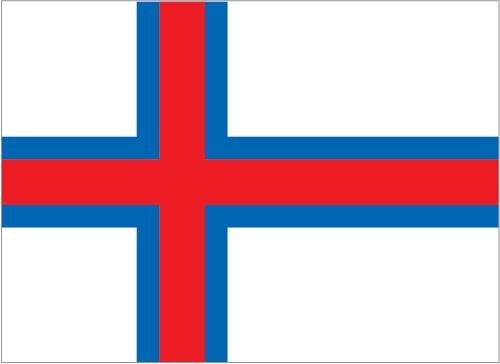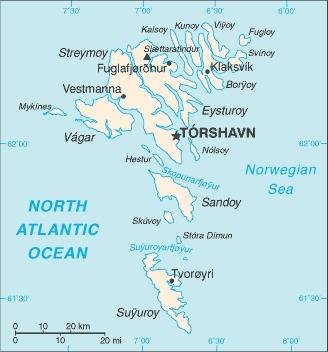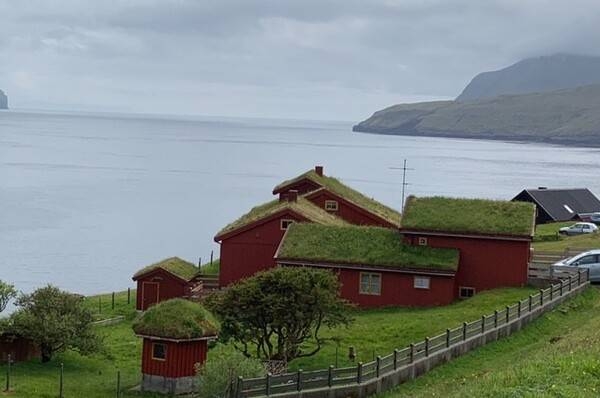64 Faroe Islands (Denmark)

White with a red cross outlined in blue extending to the edges of the flag. The vertical part of the cross is shifted toward the hoist side in the style of the Dannebrog (Danish flag). Referred to as Merkid, meaning “the banner” or “the mark,” the flag resembles those of neighboring Iceland and Norway, and uses the same three colors – but in a different sequence. White represents the clear Faroese sky, as well as the foam of the waves. Red and blue are traditional Faroese colors.
Flag courtesy of the CIA World Factbook

Map courtesy of the CIA World Factbook

The Faroe Islands are an archipelago between the Norwegian Sea and the North Atlantic Ocean. The terrain is rugged; the climate is subpolar oceanic with windy, wet, cloudy, and cool weather. Temperatures average above freezing throughout the year, hovering between 12 °C (54 °F) in summer and 5 °C (41 °F) in winter. The northerly latitude location also results in perpetual twilight during summer nights and very short winter days. Settlers introduced grass roofs to their shelters as an effective protection from the rain and cold.
Photo courtesy of the CIA World Factbook
Last updated on October 21, 2025
Government
According to Britannica, the islands are a self-governing region within the Danish state and send two representatives (elected every four years) to the Folketing, the Danish legislature. The Faroe Islands Parliament (Lagting) has 32 elected members, who in turn elect an executive body (Landsstyre) headed by a chairman. Foreign policy, defense, and the monetary and judicial systems are overseen by the Folketing. A commissioner represents Denmark in the islands. Education is based on the Danish system. The islands have good medical services. For a long time a substantial minority has sought full independence from Denmark, and in 1999 the Landsstyre entered negotiations with the Danish government about conditions for full independence. An important point in the talks was the yearly payment of one billion Danish krone from Denmark as half the export earnings.
Vága Floghavn
Government page – Vága Floghavn – the airport of the Faroe Islands
Airspace
SkyVector – Google Maps – ADS-B Exchange
ICAO countries publish an Aeronautical Information Publication (AIP). This document is divided into three parts: General (GEN), En Route (ENR) and Aerodromes (AD). ENR 1.4 details the types of airspace classes they chose to adopt from classes A through G.
Naviair
Naviair has been designated by the Danish Civil Aviation and Railway Authority to provide air navigation services.
They share some material on drones on their website. You should check out this interactive map.
Drone Regulations
Government website for visitors – Drone flying in the Faros Islands is regulated by Danish law.
The authorities in charge are Trafik-, Bygge- og Boligstyrelsen
Advanced Air Mobility (AAM) Regulations & Policies
None found by the author.
However, should you, the reader, happen to stumble across something to the contrary, please email the author at FISHE5CA@erau.edu and you may be mentioned in the ACKNOWLEDGEMENTS section of this book by way of thanks for contributing to this free eBook!
Advanced Air Mobility (AAM) News
None found by the author.
However, should you, the reader, happen to stumble across something to the contrary, please email the author at FISHE5CA@erau.edu and you may be mentioned in the ACKNOWLEDGEMENTS section of this book by way of thanks for contributing to this free eBook!
Short Essay Questions
Scenario-Based Question
You have been hired by a Drone Startup Company. Your boss has immediately assigned this job to you.
They need you to prepare a one-page memo detailing the legalities of using a drone to film the Faeroe Islands, pictured above.
They need you to mention any national laws and local ordinances.
They specifically want to know what airspace (insert pictures) you will be operating in and whether or not you need an airspace authorization.
Does it matter whether or not you are a citizen of the country?
Lastly, there is a bonus for you if, as you scroll through this chapter, you find any typos or broken links!
Short Essay Questions
- What are the drone categories?
- How is registration addressed?
- How is remote ID addressed?
- What are the model aircraft rules?
- What are the commercial drone rules?
- Are there waivers or exemptions to the rules? If so, for what?
- Would you share a link to an interactive airspace map?
- How is BVLOS addressed?
- How can you fly drones at night?
- How can you fly drones over people?
- Where do you find drone NOTAMs?
- What are the rules for drone maintenance?
- What are the rules for an SMS program?
- What are some unique rules not mentioned above?
- What are the C-UAS rules?
- What are the AAM rules?

